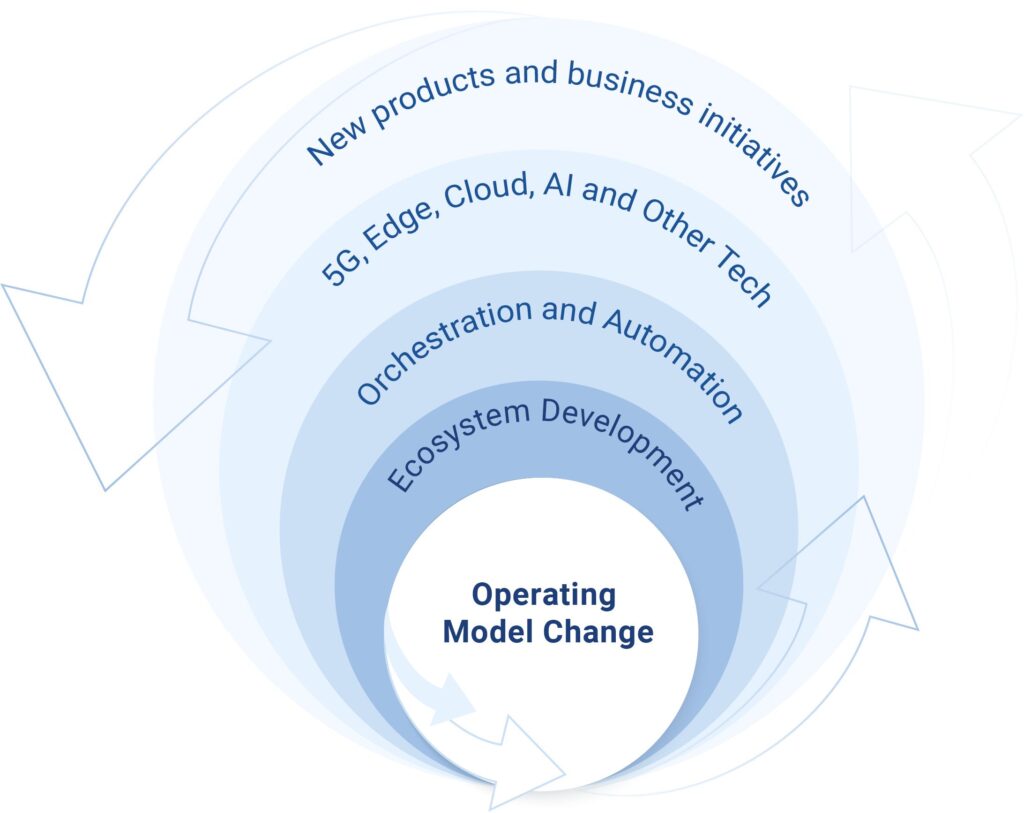
The telco industry is developing rapidly. For example, key topics that the TM Forum has identified and discussed for 2022 are end-to-end orchestrated flows for 5G; MEC and mobile private networks; and the telecommunications provider as platform operator. Even this excerpt from the list of current trend topics makes it clear that technology plays a decisive role in a CSP’s recipe for success, for without an appropriate technological basis, it is impossible to manage these tasks.
The problem: Currently, innovative measures and initiatives often fail due to the number of compromises that decades-old IT imposes. These are often historically grown, sluggish, complex and networked system landscapes in which a number of formerly monolithic systems have been extended by specialized satellite systems via a variety of different interfaces. The consequence: Quick adaptation of business processes to current market requirements is difficult. The same applies for the OSS and BSS layers.
Things that when they were created and even later on seemed sensible as a quick fix, or for which there was no alternative, now present new challenges:
- Complexity and dependencies: A heterogeneous application network means that release upgrades have to be planned precisely and are especially time-consuming, since communication between the applications depends on defined release states.
- Susceptibility to errors and security gaps: Application components in a heterogeneous and complex application system that may also be distributed geographically are often subject to different responsibilities. The consequence: Friction losses and misunderstandings during coordination. Operation is usually associated with manual interventions. This increases the error rate. Since the heterogeneity increases the number of possible attack vectors and attacks can be hidden better, the overall system is less secure.
- Redundancies and inconsistencies: Due to individual data storage, data is replicated among the systems; there are few clear restrictions.
- Costs and customer experience: On the one hand, the complexity makes it difficult to offer a good customer experience; on the other hand, to adjust flexibly to changing influencing factors. Costs for operation, support, and maintenance increase exponentially.
Under these conditions, of course it is difficult to integrate new functions quickly and easily. That is, to launch innovations on the market quickly.
What Would the Optimal System Look Like?
Let’s take a step back and imagine what a system environment would have to look like if it was based on state-of-the-art technologies and should allow a CSP to implement innovations quickly and flexibly:
- Implementation according to design thinking: User-centered processes for developing solution approaches to complex problems
- Separation of concerns: Clean separation of the functional properties
- Contract first: Definition of interfaces before definition of the functions
- Headless architecture: Separation of back and front end
- Microservice architecture: Division of the core functions into modules
- TMF standards: Interoperability with other providers, customers, partners, and suppliers
Such a clear, modular architectural principle enables the quick adjustment or combination of individual services, and thus also the prompt implementation of innovations – which makes the company fit for the future. This way, the IT processes can follow agile business behavior. In its totality, this solution is called “composable business.” A modular structure and composability are not just the underlying concept for the construction of the IT, but also for the company’s whole architecture.
Many state-of-the-art software systems work this way and profit from:
- Fewer dependencies between the application parts
- Easier maintenance of the applications
- The possibility of organization in container structures (e.g. Docker and Kubernetes) and cloud environments
- Lower costs
- Scalability
- Reliability
- Composability: Quick adjustment, changing, and re-orchestration of individual services
Step-by-Step Instead of Big Bang
Now, however, CSPs do not have the luxury of building their IT completely from scratch. While on the one hand it is necessary to create the technological basis for future innovative developments, on the other hand it is critical to guarantee ongoing operation – and in case of conversions, to consider that mainframes are frequently essential, central elements of existing systems.
Implementing such conversions step by step with guidelines for a target architecture specified in advance has proven successful. “Lift & shift” projects, where legacy systems are hauled completely into the cloud, should be also avoided in favor of the new architectural principles. A stringent, modular structure ensures that the introduction can be done step by step in an evolutionary process – entirely without a big bang.
If as few of the modules as possible depend on one another, then existing applications and functional elements can be adapted to this architecture within the project. This way, it is possible to adapt the environment and also the business flows flexibly to changing external factors as part of a continuous process.
In its “Predicts 2022: Reshaping CSP Technology and Operations Strategies,” the market research and consulting company Gartner discusses how the success of new products and business activities requires changes in the operating model:

Finding the Right Software: “Buy & Build” Principle
Because no software program can fulfill all of a CSP’s needs from the get-go, it’s worthwhile to pursue the “buy & build” solution for the conversion; that is, to start with standard software with appropriate basic functions and to expand it piece by piece. Here it has proven effective to rely on an adaptive mix of best-of-breed and open-source software. The following elements are important:
- Functionality
- Modularity and granularity
- Orchestration of the modules
- Architecture and interfaces
- Standards
- Cost structures
Thanks to the modular structure, the functional levels can be organized in layers that take on specific tasks.
It is also possible to address customers uniformly if customer contact is supported in the course of integrated flows across a wide variety of platforms and interfaces, for example websites, mobile app, e-mail, and also call centers and branch offices.
A system constructed according to these principles is not just enormously powerful, it is also equipped with wide-ranging (and expandable) functionalities, and it can be operated in cloud-native fashion.
Example of A Composable, Modular System
Composable business: Potential for the future, security for the present
Legacy systems and ongoing operation are no obstacle to implementing innovations, developing new services, and adapting the business model constantly to customers’ needs and current circumstances. Such an approach is effective in the long term, especially if the CSP pursues a composable business solution.
For step-by-step implementation, cooperation with partner companies that have expertise and experience in system analysis and the planning, implementation, and execution of such projects pays off.
Authors
Steven Bailey, Chief Strategy Officer, AOE GmbH
Steven Bailey has many years of expertise in digital transformation of international companies and the development of their business and IT visions. As Chief Strategy Officer at AOE, he is responsible for business development and customer consulting in the area of digitalisation and omnichannel e-commerce strategies.
One focus here is the development of B2X transaction portals and mobile solutions that enable companies to map new business models and generate sustainable revenue streams.
The clients he supports cover the entire range of industries – from wholesale and retail to telco, aviation, automotive, industry and life science.
In addition, the native Briton looks back on more than 20 years of experience in international brand communications and has won numerous corporate design awards. Bailey is also responsible for the idea and concept of the recently published Telco Trendbook “In 4 Steps Towards Composable Business”
Uwe Ritter, Board of Directors, People at Work Systems AG
Uwe Ritter can look back on more than 35 years’ IT experience. After completing his computer science degree in Ulm in 1983, he worked for two years as a development engineer at Dornier System GmbH in Friedrichshafen. After that, he joined Nixdorf Computer AG in 1985; he remained there in international marketing for Unix systems and as Director of the international Targon support until 1990. From 1990 to 1996, he built up the technical marketing department at Oracle Deutschland GmbH.
In 1996, Uwe Ritter was a founding member of Siebel Systems Central Europe. During his first years there, he was responsible for establishing sales support and marketing activities; then he took on various management positions in Siebel product marketing, and was finally responsible for Siebel’s entire technology basis as Executive Director. At the beginning of 2004, Uwe Ritter joined People at Work System AG as shareholder and chair. He is responsible for the areas of products, consulting, and development.